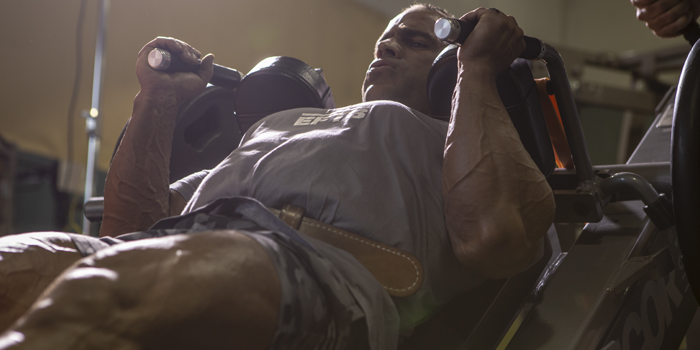
Life is chaotic. As a husband, father, business owner, and bodybuilder, very little downtime exists for me. Even if you’re a single millennial, your life is busy, right? The process of trying to find a mate, studying for college exams, binge-watching Netflix, and keeping up with your friends’ Snapchat stories is daunting. I say this partly in jest, but we do seem to be a society fixated on busyness. All of these distractions tend to sap our motivation, energy, and time to achieve effective workouts.
On the discipline spectrum, I confess that I’m wired differently from the average gym goer. Strict self-denial comes with the territory when competing in bodybuilding for 23 years. Many a day, I pushed through a workout out of necessity more so than pleasure. However, given the assiduousness of our lives, improving the efficiency of our workouts makes sense regardless of your goals. In fact, the Huffington Post recently wrote that the number-one reason people don’t work out is that life’s too hectic. This article is designed to help you to get the most bang for your buck from your gym time.
Background
I own and operate a wholesale, fresh-cut produce manufacturing business out of a 42,000-square-foot building with 80+ employees. Delving into the production side of the business over the past year led me to study Kaizen principles, better known as the Japanese philosophy of continuous improvement. I also read The Goal by Eliyahu M. Goldratt, which focuses on the process of ongoing improvement and the theory of constraints. What the heck does the theory of constraints and continuous improvement have to do with training?
RELATED: 8-Week Base Building Program for Busy Lifters
One aspect of both Japanese Kaizen and Goldratt’s theory of constraints focuses on the elimination of time. Time reduction in a manufacturing setting lowers inventory levels, reduces costs, frees up resources, increases throughput, and invariably improves the bottom line. I began to meditate on their applicability to training—specifically, increased efficiency and reduced time. For a time-strapped generation, this may prove highly beneficial. Improve your training efficiency with the following five methods.
1. Train in the Morning
Job, family, children, and social commitments have a way of derailing your evening training plans. To solve the problem, I train first thing in the morning. Sure, waking up at 4:30 AM is sometimes tough, but it assures that the “surprises” of the day don’t get in the way of a workout. Furthermore, fewer people get up to train in the morning, and those who do are serious. Less chit-chat in the AM leads to a more efficient training session. Ain’t anybody getting up before dawn to go to the gym just to engage in small talk.
Furthermore, less people means no wait time for equipment. Part of Goldratt’s book focuses on identifying and eliminating bottlenecks. Bottlenecks are identified by the amount of inventory stacking up in front of a portion of the process. Ever see three people (e.g., inventory) waiting for a single fly machine at 6 PM? Yeah, that’s a bottleneck, which is eliminated at 6 AM. Eliminate bottlenecks and you invariably increase throughput, or in this case, the speed at which a workout is completed.
2. Use HIT
I spent the better part of a decade training Dorian Yates style. High-intensity training (HIT) worked well until my joints and spine got jacked up on the heels of several muscle tears. Thankfully, I engaged John Meadows and his Mountain Dog Training method in my late 30s to extend my competitive career. Philosophically, I love John’s approach, but I recently found myself going back to my HIT roots due to time constraints for primary training sessions.
Big disclaimer: I am not doing HIT like I did in my 20s! HIT’s value is found in its efficiency, but you can do either high-impact or low-impact HIT. High-impact HIT to the extreme looks like Branch Warren’s training style. Low-impact HIT looks more like Mike Mentzer’s. I recently learned that Mike employed a two- to three-second concentric and a three- to four-second eccentric rep tempo. Two benefits to a slower rep tempo: 1) Less weight is required, and 2) there is a reduced chance of injury in the eccentric to concentric transitional phase of a rep.
3. Employ Giant Sets and Supersets
Giant and supersets increase the amount of work performed over a relatively short period of time as you move from one exercise to another without rest.
Sample Leg Training Giant Set
Sample Triceps Giant Set
Sample Biceps Superset
When you’re training strictly for strength, the lengths of rest periods play a larger role. My goal given my bodybuilding-centric focus was always hypertrophy. To some extent, the same goal applies to me today. I care a bit more about functionality over sheer size, but muscle is the engine burning calories, so maintaining a fair amount of muscularity matters from a favorable body composition standpoint. Giant sets and supersets decrease training time and elicit hypertrophy. Use them to shave time off your workout.
4. Use Active Recovery
Let’s assume you’re using a more traditional 3-4 working sets per exercise with a 60- to 90-second rest period between sets. You can multitask by taking selfies between sets, or you can hit minor body parts, like abdominals and calves, as an active form of recovery. Come on, you can do it, millennials! Despite the separation anxiety, you might feel when leaving your sacred iPhone in the car, think about the increased throughput and training efficiency you’ll gain with active recovery. You stand to save 15 minutes training abs or calves at the end of your workout by sprinkling them in between the working sets on your primary lifts. Four times per week and you just gained an hour. Extend that out one year and it’s 52 hours.
5. Don’t Skimp on Intra-Workout Nutrition
People tend to get hung up on finding the perfect training program. I’m here to tell you that most beautifully designed programs won’t make up for a lack of effort. Tenacious, unrelenting effort trumps programming. But what’s the point in working hard in the gym if you’re not recovering? It’s like running a manufacturing line with the utmost efficiency and failing to conduct preventive maintenance. Eventually, breakdowns will cancel any gains in throughput.
I’m an avid believer in Biotest Plazma, and I’m not paid to say that. It simply works better than anything else on the market. I assure you that I’ve tried everything. The uniqueness of the structured carb and protein ingredients, coupled with beta alanine and citrulline malate, make this my go-to for every workout. Regardless of your intra-workout selection, make sure that you’re doing more than drinking water. Jump-start recovery when blood flow to your muscles is greatest—intra-workout.
Wrap-Up
To conclude, a hectic, busy life is no excuse to give up on gym progress or training altogether. You simply need to train smarter, not harder or longer. Brief, intense workouts can be highly effective. Therefore, train in the morning when fewer bottlenecks exist, explore low-impact HIT, use giant sets and supersets, employ active recovery techniques, and ensure that you’re nutritionally capitalizing on the workout window. There’s no reason you can’t improve with as little as 40 minutes four times per week.











Glad you enjoyed the article. I often read my bible first thing in the morning as well; before leaving for the gym. I also meet with some guys on Tuesday mornings after training and before work.
I feel like I'm praying all the time...don't really schedule that into my day, lol!
Fight the good fight!
Mark